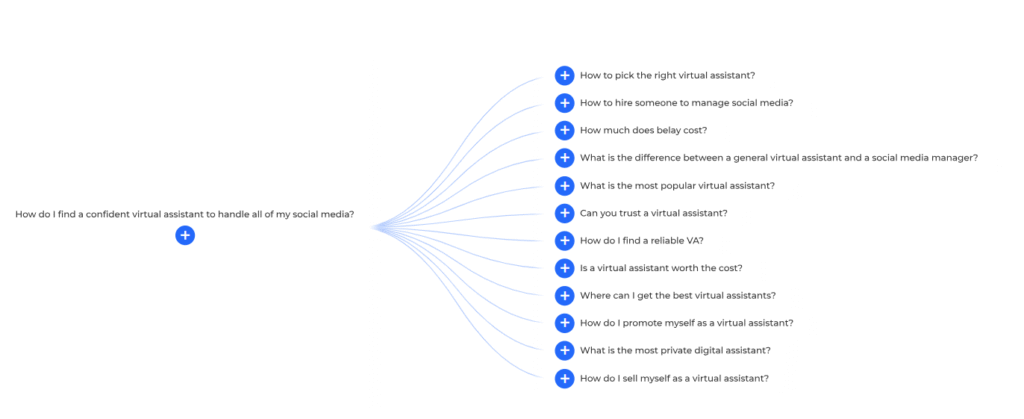The brutal truth about starting a freelance blog
You’re David facing Goliath, armed with nothing but determination and a WordPress theme. Every keyword you research seems owned by marketing giants with million-dollar budgets and domain authority scores that make you weep. But here’s what those intimidating competitors don’t want you to know – there’s a backdoor to traffic that’s sitting wide open, practically begging for your attention.
That backdoor? Long-tail keywords. And in 2025, they’re not just helpful – they’re absolutely essential for new blogs that want to see traffic within months, not years.
Quick Note: If you have not yet read our article SEO for Beginners, our introduction for freelancers who want to get their blog discovered in search, then follow the link in this paragraph to learn a little more before you plunge deeper into this article. You can always come back and read here once you have finished the previous article 😊

What Exactly Are Long-Tail Keywords?
Imagine walking into a crowded restaurant and shouting “Food!” versus walking up to the host and saying, “I’d like a table for two with a gluten-free menu, preferably by the window, around 7 PM.” The second approach is specific, intentional, and much more likely to get you exactly what you want.
Long-tail keywords are highly specific search queries that have lower search volumes but more refined intent. While a short-tail keyword might be “freelancing,” a long-tail version could be “how to find freelance writing clients without experience” or “best freelance project management tools for remote teams.”
Here’s the magic: over 75% of search queries are long-tail keywords and they have an average conversion rate of 36%. Compare that to the highest-performing landing pages, which only convert at 11.45%, and you’ll understand why smart freelancers are betting their entire content strategy on these longer, more specific phrases.
Why 2025 Is the Golden Year for Long-Tail Strategy
The search landscape has fundamentally shifted. AI chatbots, voice search through assistants like Alexa, and Google’s Search Generative Experience (SGE) are all changing how users interact with search engines. Instead of typing brief phrases to find what they need, users are beginning to use more conversational language.
Voice Search Revolution
By the end of 2024, there were an estimated 8.4 billion voice assistant devices worldwide. When someone asks Alexa, “What’s the best project management tool for a freelance graphic designer working with multiple clients?” they’re naturally using long-tail keywords. If your content targets these conversational queries, you’re positioning yourself exactly where the traffic is heading.
The Competition Problem
Analysis indicates that 82% of generic keywords will be responded to by smart bubbles such as Google’s Knowledge Graph. This means users get answers without clicking through to websites. For broad keywords like “SEO” or “freelancing,” you’re increasingly fighting for crumbs. But for specific queries like “how to track billable hours as a freelance consultant,” there’s still real estate available.

“The ultimate search engine would basically understand everything in the world, and it would always give you the right thing. And we’re a long, long ways from that”.
– Larry Page
The Hidden Psychology of Long-Tail Searchers
Here’s what most freelancers miss: people searching for long-tail keywords are probably highly interested in the topic and, in many cases, ready to convert.
Think about it this way:
- “Freelancing” = Someone doing preliminary research, maybe months from taking action
- “How to write a freelance contract for recurring clients” = Someone ready to implement, possibly tonight
The specificity reveals intent. Long-tail searches aren’t just longer – they’re also more specific and usually have commercial or transactional search intent. These searchers aren’t browsing; they’re hunting for solutions.
Your Free Long-Tail Research Toolkit
The beauty of long-tail keyword research? You don’t need expensive tools to get started. Here are battle-tested free methods:
Google’s Built-In Intelligence
Start with Google’s autocomplete feature. Type your main topic and let Google show you what people are actually searching for. The auto-suggestion feature of Google search is your first free tool, which will allow you to easily find long-tail keywords in any niche.
Try variations like:
- “How to [your topic]”
- “[Your topic] for beginners”
- “Best [your topic] without”
- “[Your topic] mistakes to avoid”
People Also Ask Goldmine
Google’s “People Also Ask” section is essentially a free keyword research tool. This tool shows you common questions asked around any keyword or topic in search engines. Each question is a potential long-tail keyword that could become a blog post.

Free Tools That Deliver
AnswerThePublic provides visualization of questions, prepositions, and comparisons around your seed keyword. It’s particularly effective for finding question-based long-tail keywords.
Keyword.io offers a comprehensive free version that generates hundreds of keyword ideas for your topic, that you can easily filter, download and add to your campaigns.
Ubersuggest provides limited but valuable free searches, showing search volume, competition, and seasonal trends for long-tail variations.
SEO.AI’s Long-Tail Generator allows you to generate valuable long tail keywords in seconds, accompanied by Google search volume and keyword difficulty. All for free.
Much of the lifeblood of blogs is search engines – more than half the traffic for most blogs
Matt Mullenweg



Advanced Free Technique: Forum Mining
Forum sites and message boards like Quora and Reddit can help you find long-tail keyword ideas. Search for your topic on these platforms and look at:
- Question titles that get high engagement
- Comments asking for specific advice
- Problems mentioned repeatedly
These real conversations reveal exactly how your audience thinks and searches.
Strategic Implementation: Getting Results Fast
The 3-2-1 Content Formula
Target three long-tail keywords per piece of content, but focus on two primary variations, with one being your main target. This approach prevents keyword stuffing while maximizing your ranking potential.
Match Search Intent Precisely
Considering the user’s search intent means providing users with what they’re seeking. In other words, adding your keyword to your page isn’t enough. To rank highly, your content needs to satisfy the user’s search intent.
For “how to set freelance rates for logo design,” don’t just mention pricing – provide a complete guide with examples, calculations, and templates. Give searchers exactly what they came for, and Google will reward you.
Location + Niche = Local Long-Tail Gold
Combine your freelance specialty with location-based modifiers:
- “Freelance web developer Manchester UK”
- “Content writer for startups in London”
- “Virtual assistant services Birmingham small business”
These hyper-specific combinations often have minimal competition but high conversion potential.
Common Beginner Traps (And How to Avoid Them)
Trap #1: Chasing Zero-Volume Keywords
Just because a keyword shows “0” searches doesn’t mean it’s worthless. Many conversational, long-tail phrases now fall into this category but drive high-intent traffic. Tools often can’t track every variation people use, especially with voice search.
Trap #2: Keyword Stuffing
Focus on two to three low-volume keywords. When integrating them into your piece, don’t stuff them into your content – EVER!. Modern Google algorithms prioritize natural, helpful content over keyword density.
Trap #3: Ignoring User Experience
Your content must solve problems, not just rank. If your blog post or web page provides valuable information that matches the user’s search intent, they’re more likely to spend time on your site, read your content, and share it with others.
The Compound Effect: Building Authority Through Specificity
Here’s where long-tail keywords become truly powerful for freelancers: they help you build topical authority. Long-tail keywords can help improve your blog strategy by offering you more room to explore a wider range of niche topics within your industry, helping you establish yourself as a go-to source of knowledge.
Instead of competing for “freelance marketing,” you become the authority for:
- “Email marketing for B2B SaaS freelancers”
- “Social media strategy for freelance consultants”
- “Content marketing tools for solo entrepreneurs”
Each specific piece builds your expertise in Google’s eyes and your audience’s trust.
Measuring Success: What Actually Matters
Forget vanity metrics. Focus on:
Rankings in Positions 1-3: Long-tail keywords offer targeted traffic, higher conversion rates, and less competition. Track your movement in top positions, not just any ranking.
Engagement Metrics: Time on page, bounce rate, and internal link clicks reveal if your content truly satisfies search intent.
Conversion Tracking: Set up goals for email signups, consultation requests, or whatever action matters most to your freelance business.

Your 30-Day Quick-Win Strategy
Week 1-2: Research and Plan
- Use free tools to identify 50 long-tail keywords in your niche
- Analyze top-ranking content for your chosen keywords
- Create a content calendar targeting one long-tail keyword per piece
Week 3-4: Create and Optimize
- Write detailed, helpful content that fully answers each keyword’s intent
- Include related keywords naturally throughout
- Optimize titles, meta descriptions, and headers
Month 2 and Beyond: Scale and Refine
- Monitor which content performs best
- Update and expand successful pieces
- Go back and review your older blog posts – you can always improve your writing and add more visual content.
The Bottom Line: Your Unfair Advantage
While established businesses fight over expensive, competitive keywords, you can build genuine authority and traffic through strategic long-tail targeting. By identifying less competitive long-tail terms and incorporating them into your keyword strategy, you can maximize the results of your SEO efforts.
The freelancers who understand this advantage now – who start targeting “how to create a freelance content strategy for fintech startups” instead of just “content strategy” – will be the ones dominating their niches by 2026.
Your competitors are still playing the old game. The question is: will you join them in fighting over scraps, or will you use long-tail keywords to carve out your own profitable corner of the internet?
The tools are free. The opportunity is massive. The only question left is whether you’ll take action before everyone else catches on.
As a side-note, I asked a friend of mine who has been building content sites for his clients for many years. My question to him was simply this:
“Mike, if you were going to expand upon this article we wrote to dive deeper, what would you suggest to explore that would really give beginner freelancers an edge when starting out, but would be simple enough for them to actually implement?”
His answer was simple, but quite specific, so I thought I would share it here for you.
Looking at the current article and thinking about what would give beginner freelancers a real competitive edge, I’d suggest expanding into these high-impact, beginner-friendly areas:
1. The “Content Cluster” Strategy for Freelancers
Most beginners write random blog posts. The edge comes from creating topic clusters around long-tail keywords that establish immediate authority:
- Main pillar: “Freelance copywriting for small businesses”
- Supporting long-tails: “How to write email sequences for local restaurants,” “Website copy templates for service businesses,” “Pricing copywriting projects for startups”
This is simple to implement but creates an SEO powerhouse that Google recognizes as comprehensive coverage.
2. The “Problem-Solution Bridge” Framework
Instead of just targeting keywords, teach them to identify the emotional journey behind long-tail searches:
- Problem-aware: “Why do my freelance clients always ask for revisions”
- Solution-aware: “How to set clear expectations with freelance clients”
- Implementation-ready: “Freelance client onboarding checklist template”
This creates content that naturally converts because it matches exactly where people are in their decision-making process.
3. Local + Online Hybrid Targeting
Most freelancers miss this goldmine:
- “Virtual assistant for San Diego accountants”
- “Freelance social media manager Birmingham, Alabama restaurants”
- “Remote graphic designer specializing in London startups”
These have almost zero competition but high conversion rates because they’re hyper-specific to both service and location.
4. The “Competitor Content Gap” Method
A simple process using free tools:
- Find 3-5 successful freelancers in your niche
- Use Ubersuggest’s free version to see what they rank for
- Look for long-tail keywords they rank for positions 4-10
- Create better, more comprehensive content targeting those exact terms
This is like finding treasure maps your competitors dropped.
5. Voice Search Optimization for Freelancers
Since voice searches are naturally long-tail and conversational:
- Target question-based keywords: “How much should I charge for…”
- Include FAQ sections in every post
- Write in natural, conversational language that mirrors how people actually speak
6. The “Tool Stack” Content Strategy
Create content around specific tool combinations:
- “Using Canva and Buffer for freelance social media management”
- “Notion templates for freelance project management”
- “Zoom and Calendly setup for freelance consultations”
These are incredibly specific, have buying intent, and establish you as someone who knows the practical side of freelancing.
Long Tail Keywords in 2025 – Is it still current and relevant? If so, how should you be using this in your own business?
The Podcast below is an AI produced Podcast Episode based upon our Keyword Blueprint Report for 2025. Have a listen below. If you would like a copy of the 50+ page report, you can access it here.
This audio podcast is a discussion about the guide, authored by Martin Salter, providing a realistic and practical framework for freelancers and small service businesses to drive organic traffic by utilizing long-tail keyword strategies.
It emphasizes moving away from highly competitive, generic keywords towards specific, niche phrases that target clients ready to hire. The content outlines a step-by-step approach covering keyword research using the Service-Audience-Problem framework, content creation aligned with search intent, and methods for converting visitors into clients.
Additionally, it offers strategies for scaling content efforts through systematic workflows and repurposing, while also addressing advanced topics like local SEO, voice search optimization, and future-proofing strategies against AI impacts.
Secure Your Copy of our Latest 2025 Report
Long-Tail Keyword Strategy: A Practical Guide for Freelancers and Small Service Businesses

Stop competing with corporate giants for generic keywords like “marketing consultant” or “web designer.” This comprehensive guide shows you how to dominate specific search phrases your ideal clients actually use when they’re ready to hire—like “email marketing specialist for B2B software companies” or “WordPress design for veterinary clinics.”
What You’ll Get:
- Complete 6-chapter system with step-by-step implementation
- Service-Audience-Problem Framework for keyword research
- Ready-to-use templates and worksheets
- Content creation strategies that convert visitors to clients
- Scaling systems for sustainable growth
- Advanced local SEO and voice search optimization
Realistic Results Timeline:
- 3-6 months: Rank on page one for 5-15 targeted keywords
- 6-12 months: Regular inbound inquiries from search traffic
- 2-5x increase in qualified website visitors
- Improved lead quality and reduced dependence on cold outreach
Time Investment: 2-4 hours per week with 6+ month commitment required.
What Makes This Different: No unrealistic promises or “guru secrets”—just proven strategies based on current search engine practices. Includes competitor analysis techniques, content optimization standards, consultation processes, and troubleshooting guides.
Perfect For: Freelancers and small service providers tired of losing to big companies on generic searches and ready to build sustainable organic traffic through strategic, specific keyword targeting.
Contains comprehensive resource section with tool recommendations, implementation timeline, and quality checklists for immediate action.
Your First Steps to Freelance Freedom
